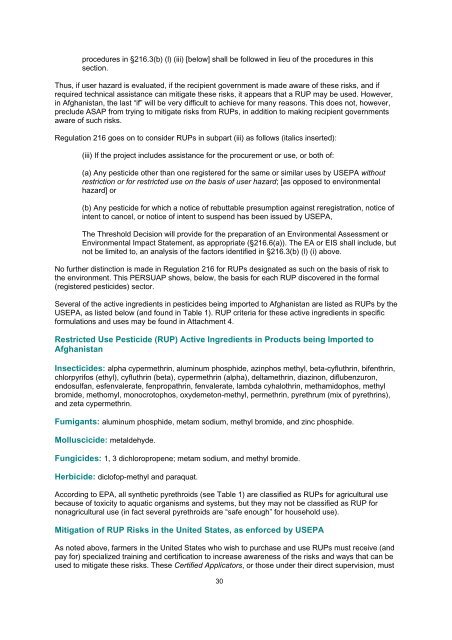Afghanistan Accelerating Sustainable Agriculture ... - part - usaid
Afghanistan Accelerating Sustainable Agriculture ... - part - usaid
Afghanistan Accelerating Sustainable Agriculture ... - part - usaid
Create successful ePaper yourself
Turn your PDF publications into a flip-book with our unique Google optimized e-Paper software.
procedures in §216.3(b) (l) (iii) [below] shall be followed in lieu of the procedures in this<br />
section.<br />
Thus, if user hazard is evaluated, if the recipient government is made aware of these risks, and if<br />
required technical assistance can mitigate these risks, it appears that a RUP may be used. However,<br />
in <strong>Afghanistan</strong>, the last “if” will be very difficult to achieve for many reasons. This does not, however,<br />
preclude ASAP from trying to mitigate risks from RUPs, in addition to making recipient governments<br />
aware of such risks.<br />
Regulation 216 goes on to consider RUPs in sub<strong>part</strong> (iii) as follows (italics inserted):<br />
(iii) If the project includes assistance for the procurement or use, or both of:<br />
(a) Any pesticide other than one registered for the same or similar uses by USEPA without<br />
restriction or for restricted use on the basis of user hazard; [as opposed to environmental<br />
hazard] or<br />
(b) Any pesticide for which a notice of rebuttable presumption against reregistration, notice of<br />
intent to cancel, or notice of intent to suspend has been issued by USEPA,<br />
The Threshold Decision will provide for the preparation of an Environmental Assessment or<br />
Environmental Impact Statement, as appropriate (§216.6(a)). The EA or EIS shall include, but<br />
not be limited to, an analysis of the factors identified in §216.3(b) (l) (i) above.<br />
No further distinction is made in Regulation 216 for RUPs designated as such on the basis of risk to<br />
the environment. This PERSUAP shows, below, the basis for each RUP discovered in the formal<br />
(registered pesticides) sector.<br />
Several of the active ingredients in pesticides being imported to <strong>Afghanistan</strong> are listed as RUPs by the<br />
USEPA, as listed below (and found in Table 1). RUP criteria for these active ingredients in specific<br />
formulations and uses may be found in Attachment 4.<br />
Restricted Use Pesticide (RUP) Active Ingredients in Products being Imported to<br />
<strong>Afghanistan</strong><br />
Insecticides: alpha cypermethrin, aluminum phosphide, azinphos methyl, beta-cyfluthrin, bifenthrin,<br />
chlorpyrifos (ethyl), cyfluthrin (beta), cypermethrin (alpha), deltamethrin, diazinon, diflubenzuron,<br />
endosulfan, esfenvalerate, fenpropathrin, fenvalerate, lambda cyhalothrin, methamidophos, methyl<br />
bromide, methomyl, monocrotophos, oxydemeton-methyl, permethrin, pyrethrum (mix of pyrethrins),<br />
and zeta cypermethrin.<br />
Fumigants: aluminum phosphide, metam sodium, methyl bromide, and zinc phosphide.<br />
Molluscicide: metaldehyde.<br />
Fungicides: 1, 3 dichloropropene; metam sodium, and methyl bromide.<br />
Herbicide: diclofop-methyl and paraquat.<br />
According to EPA, all synthetic pyrethroids (see Table 1) are classified as RUPs for agricultural use<br />
because of toxicity to aquatic organisms and systems, but they may not be classified as RUP for<br />
nonagricultural use (in fact several pyrethroids are “safe enough” for household use).<br />
Mitigation of RUP Risks in the United States, as enforced by USEPA<br />
As noted above, farmers in the United States who wish to purchase and use RUPs must receive (and<br />
pay for) specialized training and certification to increase awareness of the risks and ways that can be<br />
used to mitigate these risks. These Certified Applicators, or those under their direct supervision, must<br />
30

















